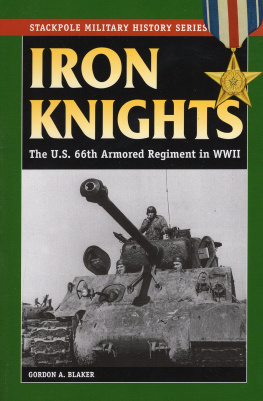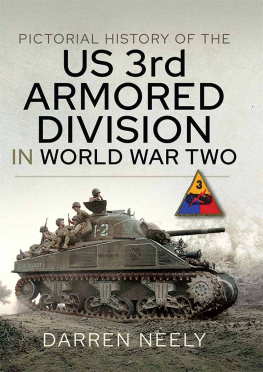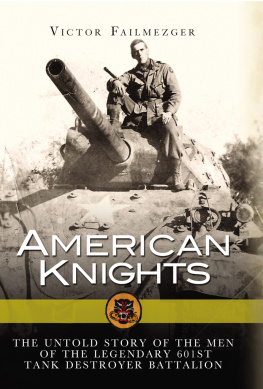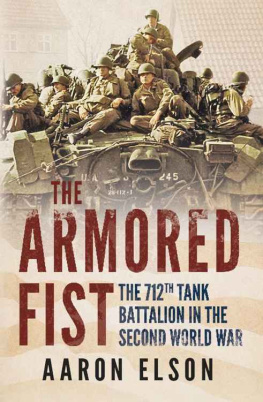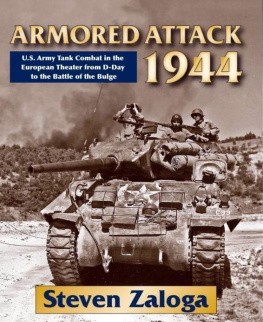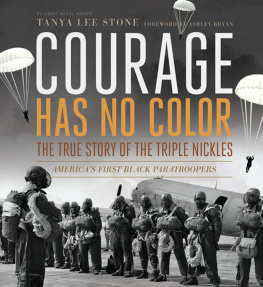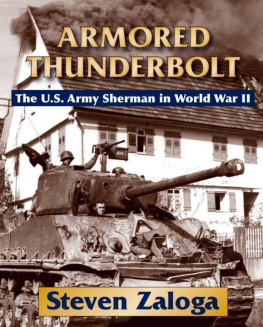ACKNOWLEDGMENTS
IN 2005 MILITARY OFFICER MAGAZINE ASKED THAT I WRITE AN article on the 761st Tank Battalion for its Black History Month issue in February 2006. I informed the editor that if the unit was worth a story, the magazine was doing a disservice to the men, pigeon-holing them by race. The 761st Tank Battalion has a fabulous and in many ways timeless story. The value of this unit and its men exceeds an article and surpasses what this book conveys.
I have written The Black Panthers: A Story of Race, War, and Courage mainly from the primary sources of the periodthe as-it-happened reports, letters, news articles, and the like. I have tried to write it through the men's eyes, the lens of 19421945. The book tells the story of a remarkable unit during an equally remarkable time. These men fought for their country like millions of other Americans. I hope the facts speak for these combat tankers and the people that cared about them.
I would like to thank Michael Neff, director of Algonkian Writers Conferences, for insisting I needed to write this book, as I sat bewildered on a train bound for New York to pitch another written work. I cannot say enough about the public and private archives that struggle to keep their doors open for the seekers of the seemingly obscure information and morsels that can make a character or a story come alive. This includes the National Archives, College Park, Maryland; the National Personnel Records Center, St. Louis; the Robert W.Woodruff Library, at Clark Atlanta University; and Tulane University's Armistead Center, New Orleans. University archivists Barbara OBrien at McDaniel College (Western Maryland) and Christina Zamon at Emerson College proved especially helpful. Nancy Lyon, the archivist at Yale University as well as Baylor University, provided valuable information. Thanks go to Guy Nasuti at the Military History Institute, Carlisle, Pennsylvania. The interlibrary loan program through the public library system proved invaluable. Thank you to the city of Alexandria, Virginia, for participating in this worthwhile network. Thank you to Bonnie Henning at the Institute of Heraldry for sharing a rich history of unit insignia.
Many thanks to the people within the Department of the Army. Fort Benning, Georgia, which is now home to both the U.S. Army Infantry and Armor centers, opened its doors to me. Armor Museum curator Len Dyer shared his knowledge and the army's vast tank collection. Fort Hood historian Richard Powell, whom Hood lost for budgetary reasons, helped with the Camp Hood portion of the story. Alexandria, Louisiana, historian Dale Genius shared his knowledge as well as little-known artifacts from now-closed Camp Claiborne.
The historians whose doorsteps I have darkened have been as helpful as they have been patient. I marvel at their knowledge and understanding of history within and beyond their specialties. Alexandria, Louisiana, historian Dale Genius shared his knowledge as well as little-known artifacts from now-closed Camp Claiborne. Fred Borch, now historian for the army's Judge Advocate General School in Charlottesville, Virginia, is as gifted and thorough a historian as he is a lawyer. Thank you to Dr. Robert S. Cameron, the U.S. Army's armor historian and author of the riveting as well as rollicking Mobility, Shock, and Firepower: The Emergence of the US Army's Armor Branch, 19171945. He understood my work and supported me any way he could. Glenn Williams, a senior historian at the Army's Center of Military History, Washington, D.C., probably rues the day he picked up the phone and found me on the other end. Glenn underscores the value of Army historians. Though his specialty lies in the eighteenth century he can discuss World War II, the Civil War, the War of 1812, and the best on the Baroque music scene, or most any topic in accurate detail. Glenn, a truly selfless and kind gentleman and scholar, helped me with this project, probably at the cost of his own. He remains a great and trusted friend who kept me from losing hope as well as my sanity.
There would be no book without the unit and its tankers. At this point, seventy years later, there would be no book without their families. William McBurney remains my shy, but optimistic teen and it has been a privilege to talk with him. Russell Guthrie retains the energy of that sixteen-year-old who falsified his age to enlist. They were kind enough to talk from a World War II period perspective.
John Weston, a member of the first group of black tankers in history, lent great insight, and retired U.S. Army Colonel Aaron Dotson shared his memories of Warren Crecy. Lillian Torchy McConnell, widow of tanker E.G. McConnell, shared her collection of images. Louise Latimer shared her memories of husband Philip. The English, Crecy, Dade, McBurney, and Guthrie families helped and supported me where they could.
I would have been nowhere without the Bates and Harrison families, specifically Baron Bates and Ivan Harrison, Jr. They opened their parent's lives to me and hung with me through the journey. We discovered unknown aspects of their parents lives. These finds proved thrilling for me and probably unnerving for them, but they continued to trust me and helped with access in many areas.
There is nurse and poet Mrs. Paul Bates, the name she prefers to be known by. She appears in this book as Taffy or Helen Rosen. She is as beautiful and outspoken as the day she volunteered for the Army Nurse Corps. She has retained the strength and resilience she took with her when she left home at seventeen. Mrs. Bates opened her home to me, and trusted me with Paul Bates's letters that span much of the war. Without her gracious support there may have been no story. She remains my heroine on many levels, and I am sorry I could not write more in this book on this remarkable woman. She could have refashioned herself in any way she wanted, but chose a future with Paul Bates, making his life all the brighter. Sitting close with Mrs. Bates and reading her poetry aloud to her remains one of my most poignant experiences.
Thanks also to Bruce H. Franklin of Westholme Publishing for believing in this unit and this work and taking a chance on me, and his associates, Noreen OConnor-Abel, Trudi Gershenov, Paul Dangel, John Hulse, and Mike Kopf.
To my Rudy Schulz, a retired U.S. Army lieutenant colonel whose father was firing back at the Allies as a German child soldier of sixteen, I have put you through hell. Thank you for being the stable one.
Finally, I have to thank all the men of the 761st, those still with us, those taken from us in battle, and those who left us in the years after the war. We have spent nearly two years together living, training, and fighting more battles across Europe than can be recounted here. You allowed me to be a part of your unit throughout the journey. Sam Turley, it is as if I watched you sacrifice yourself outside Morville. If I had to point to a Medal of Honor-worthy action, yours was it. You saved a company and quite possibly the battalion. All of you already know how much you mean to me.
BIBLIOGRAPHY
EVANGELINE PARISH (LA.) GOVERNMENT STATISTICS
DILLARD UNIVERSITY ARCHIVES
FORT BENNING, DONOVAN LIBRARY HOLDINGS
After-action Report for December 1944, 28th Infantry Division, dated January 4, 1945.
History of a Combat Regiment 19391945: 104th Infantry.
History of a Combat Regiment: The 104th Infantry.
Holtz, (Major) Werner. The Operations of Company C, 104th Infantry (26th Infantry Division) from Vic-sur-Seille to Albestroff, Eastern France, 821 November 1944 (Rhineland Campaign) 19471948.
Krainik, Captain Edward B. The Allied Counterattack 26 December 194427 January 1945 (19481949).
Lorraine Campaign, 26th Infantry Division 5 October 1944 to 13 December 1944, dated 17 January 1945.



